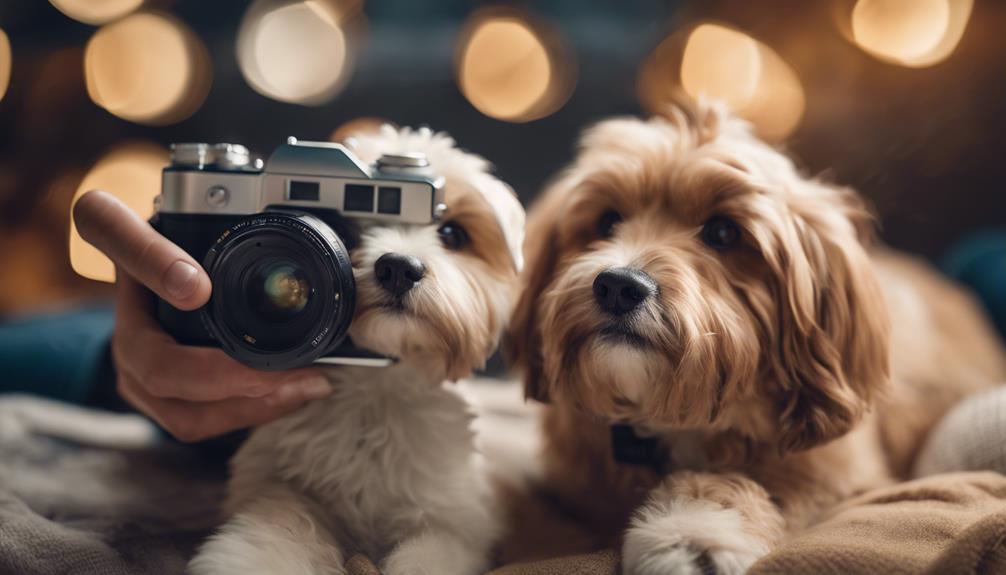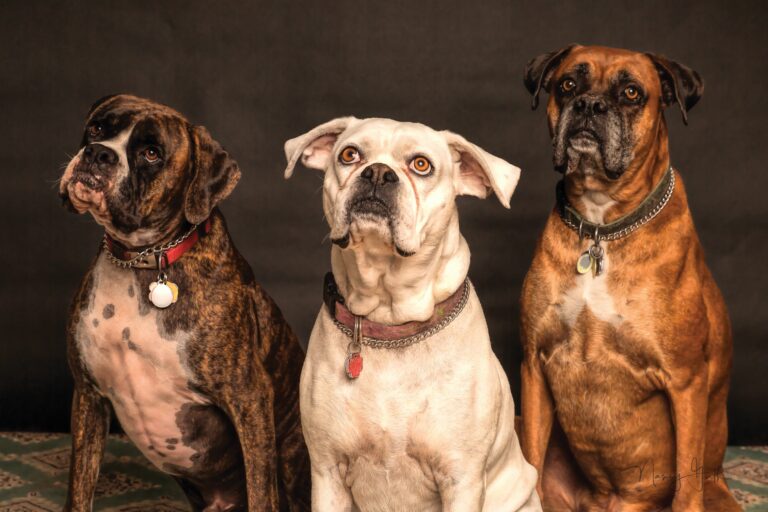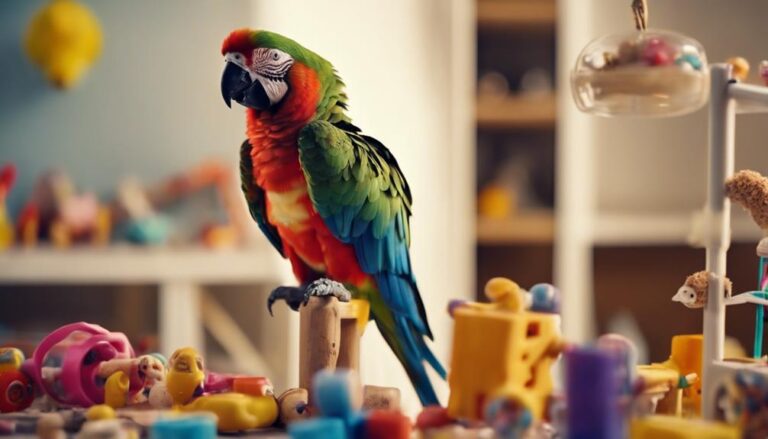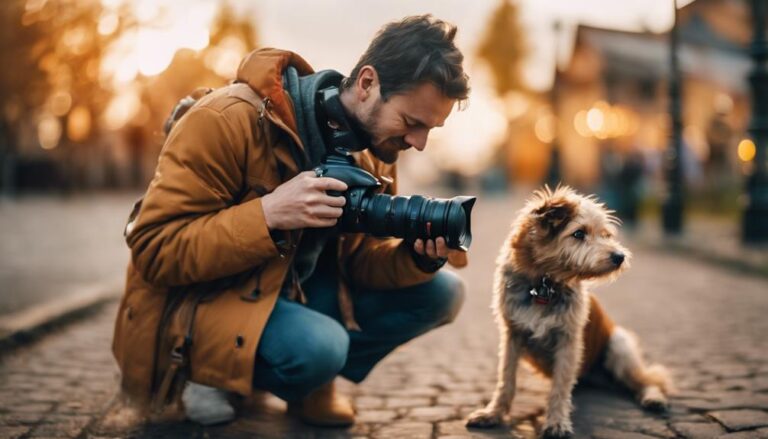To excel in pet photography, focus on improving photography skills like using light creatively. Understanding animal behavior helps capture authentic shots. Being patient and empathetic creates a positive atmosphere. Technical knowledge on lighting and equipment is key. Experience with animals builds trust for great captures. Learn how to handle indoor and outdoor lighting effectively. Mastering these qualifications sets you up for stunning pet portraits.
Photography Skills
When capturing pet photos, honing your photography skills ensures you can beautifully preserve those precious moments with clarity and artistry. To excel in pet photography, it's vital to stay updated on the latest animal photography trends and incorporate them into your work. Here are some photography tips to enhance your pet photography skills:
Firstly, lighting plays an important role in capturing stunning pet photos. Natural light is often the best choice as it enhances the colors and textures of your pet's fur. Avoid using harsh overhead lights that can create unflattering shadows. Instead, opt for soft, diffused lighting for a more pleasing effect.
Secondly, focus on capturing your pet's unique personality and emotions. Candid shots that showcase your pet's natural behavior often make the most engaging photos. Try to get down to your pet's eye level to create a more intimate connection in your photos.
Lastly, experiment with different angles and compositions to add variety to your pet photography portfolio. Don't be afraid to get creative and try out unconventional shots. Incorporating elements of nature or using props can also enhance the overall aesthetic of your pet photos.
Understanding Animal Behavior
To excel in pet photography, understanding animal behavior is essential to capturing authentic and engaging moments. Animals communicate primarily through body language, using a variety of cues to express their emotions, needs, and intentions. By learning to interpret these signals, you can anticipate their actions and reactions, allowing you to capture photos that truly reflect their personalities.
Animal body language plays a vital role in pet photography. For example, a dog wagging its tail may indicate excitement or happiness, while flattened ears could signal fear or discomfort. Similarly, a cat that arches its back may be feeling threatened, whereas a relaxed posture often signifies contentment. By observing and recognizing these subtle cues, you can adjust your approach to make sure the animal feels comfortable and at ease during the photoshoot.
Communication cues are another important aspect to take into account when photographing pets. Animals respond to tone of voice, body movements, and facial expressions, so maintaining a calm and reassuring demeanor is crucial to building trust and establishing a connection with your furry subjects. By establishing clear communication with the animals, you can create a positive environment where they feel safe to express themselves naturally, resulting in genuine and engaging photographs.
Patience and Empathy
Understanding the significance of patience and empathy is essential in pet photography to establish a connection with your furry subjects and capture genuine moments. Time management is vital in pet photography to make certain that you have ample time to build rapport with the animals, especially those who may be shy or easily distracted. By being patient and allowing the pets to acclimate to the environment, you can capture their true personalities and behaviors authentically.
Stress management is equally important, as pets can sometimes be unpredictable or uncooperative during photoshoots. Remaining calm and composed in these situations will not only help you stay focused but also reassure the pet and their owners, creating a more relaxed atmosphere for the photoshoot. Your ability to handle stress will reflect positively on your work and reputation.
Communication skills play a significant role in pet photography, not only in interacting with the animals but also in engaging with their owners. Building strong client relations through effective communication will help you understand their expectations, preferences, and the unique characteristics of their pets. Empathy towards both the animals and their owners will enable you to capture images that resonate with them on a personal level, creating a memorable experience for everyone involved.
Technical Knowledge
Developing a strong foundation in technical knowledge is crucial for mastering the art of pet photography, allowing you to confidently navigate camera settings, lighting setups, and composition techniques to capture stunning images of animals. Understanding lighting techniques is vital in pet photography, as it can greatly impact the mood and overall quality of your photos. Whether you're utilizing natural light or artificial lighting sources, knowing how to manipulate light to highlight your furry subjects will elevate your images.
Proper equipment usage is another critical aspect of technical knowledge in pet photography. Familiarizing yourself with your camera gear, lenses, and accessories will enable you to make quick adjustments on the fly to guarantee you capture those spontaneous moments with pets. Additionally, having post-processing skills can help enhance your photos further, whether it's adjusting colors, sharpening details, or removing distractions.
Creativity in composition is where technical knowledge meets artistic expression. Understanding how different angles, framing techniques, and focal points can impact the visual storytelling of your pet photos is key to creating compelling and engaging images. By combining your technical expertise with a creative eye, you'll be able to produce pet photos that not only showcase animals but also evoke emotions and connections with your audience.
Experience With Animals
Mastering the art of pet photography requires hands-on experience and familiarity with animals to capture their unique personalities effectively. Your experience with animals plays an essential role in pet photography. Understanding animal behavior, body language, and temperament can greatly enhance your ability to create stunning pet portraits.
When it comes to animal handling, it is vital to approach each pet with care and patience. Building trust with the animals you photograph is key to capturing their authentic expressions. Knowing how to interact with different species and breeds can help you create a comfortable environment for the pets during the photoshoot.
Additionally, having knowledge of various training techniques can be beneficial in pet photography. Understanding basic commands and signals can help you direct the pets to pose in a way that highlights their best features. Positive reinforcement techniques can also be useful in getting the pets to cooperate and showcase their personalities in front of the camera.
Creativity in Composition
When capturing pet photos, consider framing pet poses creatively to showcase their unique personalities and characteristics. Experiment with different lighting techniques to add depth and emotion to your compositions. By incorporating innovative composition methods, you can elevate your pet photography to new artistic heights.
Framing Pet Poses
To seize distinctive and visually engaging pet portraits, consider framing your pet poses creatively. When arranging your shot, think about pet posing tips and composition tricks that can enhance the overall appeal of the image. Position your pet in a way that showcases their personality and brings out their unique characteristics. Experiment with different angles and perspectives to create storytelling shots that evoke emotions and tell a story. Focus on capturing the essence of your pet's individuality through thoughtful framing and composition. By paying attention to these details, you can elevate your pet photography skills and produce mesmerizing images that resonate with viewers.
Lighting Techniques
Experimenting with different lighting techniques can greatly enhance the creativity in your composition when capturing pet portraits. For natural lighting tips, position your pet near a large window where soft, diffused light can highlight their features. When using indoor lighting techniques, consider using a combination of ambient light and artificial sources to create a warm and inviting atmosphere. Outdoor lighting setups offer the opportunity to play with sunlight at different times of the day for varied effects on your pet's fur and eyes. If needed, flash photography options can fill in shadows and add a pop of light to make your pet stand out. By mastering these lighting techniques, you can elevate the visual appeal of your pet photography.
Knowledge of Pet Breeds
You need to be able to identify different pet breeds accurately to excel in pet photography. Understanding the unique characteristics of each breed will help you capture their essence and personality in your photos. This knowledge will set you apart in the competitive field of pet photography.
Breed Identification Skills
Developing a strong knowledge of various pet breeds is important for pet photographers to effectively capture the unique characteristics of each animal. Understanding animal behavior and breed diversity is vital in this aspect. Breed recognition plays a significant role in pet photography as it helps you anticipate and capture specific animal characteristics. By being able to identify different breeds quickly, you can adjust your photography techniques to showcase their features better. This skill not only allows you to connect with pet owners on a deeper level but also guarantees that you can highlight the distinct traits of each breed in your photographs. Sharpening your breed identification skills will set you apart as a knowledgeable and skilled pet photographer.
Understanding Breed Characteristics
To capture the essence of different pet breeds in your photography, understanding their unique characteristics is key. This knowledge not only helps you showcase the distinct traits of each breed but also allows you to connect with your furry subjects more effectively. Here are some tips to help you master understanding breed characteristics for your pet photography:
- Study the history and origins of different breeds.
- Learn about breed-specific behaviors and temperaments.
- Familiarize yourself with the typical physical features of each breed.
- Practice capturing the personality traits that define each breed in your photographs.
Proper Equipment Usage
Mastering the art of utilizing the right tools is essential for capturing stunning pet photographs. When it comes to pet photography, proper lighting plays an important role in highlighting your furry subject's features and creating a visually appealing image. Understanding how to work with natural light or artificial lighting sources can greatly impact the quality of your photos. Additionally, knowing how to adjust your camera settings to make the most of the available light will help you achieve well-exposed and sharp images.
In addition to lighting, mastering editing techniques is also essential in pet photography. Editing software can help enhance your photos by adjusting colors, sharpness, and overall composition. Learning how to use editing tools effectively can take your pet photography to the next level, allowing you to create professional-looking images that showcase your furry clients in the best possible way.
When it comes to equipment usage, familiarizing yourself with your camera gear is crucial. Understanding how to adjust settings such as aperture, shutter speed, and ISO will enable you to capture sharp and well-exposed pet portraits. Additionally, knowing how to choose the right lenses for different shooting situations can help you achieve the desired effects in your pet photographs. By honing your skills in proper equipment usage, you can elevate your pet photography and create captivating images that truly stand out.
Post-Processing Skills
Enhancing your pet photographs through post-processing techniques can elevate the overall quality and visual appeal of your images. To master post-processing skills effectively, you need to focus on two key areas:
- Color Correction: Adjusting the colors in your pet photographs can make a significant difference in the final outcome. Proper color correction guarantees that the colors are accurate and vibrant, enhancing the overall look of the image.
- Retouching Techniques: Learning retouching techniques can help you remove imperfections, enhance details, and create a polished look in your pet photos. From eliminating distractions to enhancing fur texture, mastering retouching is vital for professional-looking images.
- Editing Software Proficiency: Proficiency in editing software such as Adobe Photoshop or Lightroom is essential for executing post-processing tasks effectively. Knowing how to use these tools will enable you to bring your creative vision to life and make necessary adjustments to your pet photos.
- Workflow Efficiency: Developing an efficient post-processing workflow can save you time and guarantee consistency in your edits. Establishing a structured workflow from importing to exporting your images will help you streamline the editing process and deliver high-quality results efficiently.
Business and Marketing Acumen
Developing strong business and marketing acumen is essential for establishing a successful pet photography venture. When it comes to pricing strategies, understanding your costs, market demand, and competitive landscape is key. Researching what similar pet photographers are charging in your area can help you set competitive yet profitable prices. Additionally, consider offering packages or discounts to attract more clients while ensuring your pricing covers your expenses and provides a reasonable profit margin.
Identifying your target market is another important aspect of business acumen. Determine the demographics and psychographics of potential clients who are most likely to seek pet photography services. Tailoring your marketing efforts to appeal to this specific audience can lead to more effective campaigns and higher conversion rates. Utilizing social media platforms to showcase your work and engage with pet owners is an excellent way to reach your target market. By consistently posting high-quality images and utilizing branding techniques that reflect your unique style, you can establish a strong online presence and attract potential customers.
Client Communication Skills
When communicating with clients in pet photography, make sure you set clear expectations, comprehend their needs, and address any concerns that may arise. By being attentive to their requirements and responsive to their feedback, you can establish trust and loyalty. Effective client communication is key to delivering a service that meets their expectations and builds lasting relationships.
Clear Communication Expectations
Successful client communication skills are crucial for establishing clear expectations in pet photography sessions. To guarantee effective communication with your clients, consider the following:
- Setting boundaries and managing expectations from the start.
- Establishing rapport and building trust to create a comfortable environment.
- Clearly outlining the photography process and what clients can anticipate.
- Encouraging open communication to address any concerns or preferences.
Understanding Client Needs
To better cater to your clients' needs in pet photography sessions, understanding their preferences and expectations is vital. Client satisfaction hinges on effective communication. By actively listening and engaging with clients, you can grasp their vision and desires for the photoshoot. Meeting expectations is essential for building trust and ensuring a positive experience. Through clear communication, you can clarify any uncertainties, address specific requests, and establish a connection that fosters trust. Understanding your clients' needs not only enhances the quality of the photographs but also contributes to overall client satisfaction. By valuing communication and attentively considering their preferences, you can tailor your pet photography sessions to meet and exceed their expectations.
Addressing Client Concerns
Understanding and addressing client concerns in pet photography sessions demands attentive listening and effective communication skills. To guarantee client satisfaction and successful sessions, consider the following:
- Client Satisfaction: Prioritize understanding and meeting the unique needs and expectations of each client.
- Pricing Strategies: Clearly communicate pricing structures and any additional costs to prevent misunderstandings.
- Handling Objections: Address any concerns or objections with empathy and professionalism to establish trust.
- Customer Service: Provide exceptional customer service by being responsive, accommodating, and proactive in resolving any issues that may arise. Remember, clear communication and a client-focused approach are key to a successful pet photography business.
Frequently Asked Questions
How Can I Attract More Clients as a Pet Photographer?
To attract more clients as a pet photographer, focus on client attraction through effective marketing strategies. Showcase your work on social media, create a professional website, offer promotions, and engage with pet owners in your community.
What Are Some Common Challenges Pet Photographers Face in the Industry?
When photographing pets, you may face challenges like handling anxious pets and dealing with distractions. Lighting issues can arise, especially in indoor settings. Deciding between outdoor and indoor photoshoots presents its own set of challenges.
How Do Pet Photographers Handle Difficult or Uncooperative Animals During a Photoshoot?
When pet photographers deal with difficult animals during a shoot, they use handling distractions and calming techniques. Patience and perseverance play a key role in creating a successful photoshoot despite challenges, ensuring a positive outcome.
What Are Some Tips for Building a Successful Pet Photography Business?
To build a successful pet photography business, focus on marketing strategies and client relationships. Develop a strong portfolio to showcase your work. Use various pricing models to attract customers. Engage with clients genuinely to establish trust and loyalty.
How Can Pet Photographers Ensure the Safety and Well-Being of the Animals They Work With During Photoshoots?
When working with animals, prioritize their well-being by understanding animal behavior and training. Guarantee pet safety by taking precautions like securing the environment, using positive reinforcement, and allowing breaks during photoshoots.
Conclusion
To sum up, to excel in pet photography, you need a combination of photography skills, understanding animal behavior, patience, technical knowledge, experience with animals, proper equipment usage, post-processing skills, business and marketing acumen, and client communication skills. By honing these qualifications, you can capture beautiful and meaningful moments with pets that will delight your clients and showcase your talent as a pet photographer.









